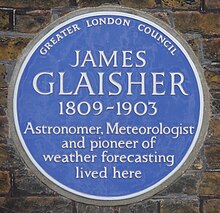James Glaisher
James Glaisher | |
|---|---|
 | |
| Born | 7 April 1809 Rotherhithe, London, England |
| Died | 7 February 1903 (aged 93) Croydon, London, England |
| Nationality | English |
| Spouse | |
| Children | 3 (incl. James) |
| Scientific career | |
| Fields | Meteorology |
James Glaisher FRS (7 April 1809 – 7 February 1903) was an English meteorologist, aeronaut and astronomer.
Biography

Born in Rotherhithe, the son of a London watchmaker,[1] Glaisher was a junior assistant at the Cambridge Observatory from 1833 to 1835[2] before moving to the Royal Observatory, Greenwich, where he served as Superintendent of the Department of Meteorology and Magnetism at Greenwich for 34 years.[3][4]
In 1845, Glaisher published his dew point tables for the measurement of humidity. He was elected a Fellow of the Royal Society in June 1849.[5]
He was a founding member of the Meteorological Society (1850) and the Aeronautical Society of Great Britain (1866). He was president of the Royal Meteorological Society from 1867 to 1868.[4] Glaisher was elected a member of The Photographic Society, later the Royal Photographic Society, in 1854 and served as the society's president for 1869–1874 and 1875–1892.[6] He remained a member until his death. He was also President of the Royal Microscopical Society. He is most famous as a pioneering balloonist. Between 1862 and 1866, usually with Henry Tracey Coxwell as his co-pilot, Glaisher made numerous ascents to measure the temperature and humidity of the atmosphere at its highest levels. His ascent on 5 September 1862 broke the world record for altitude, but he passed out around 8,800 metres (28,900 feet) before a reading could be taken. One of the pigeons making the trip with him died.[7] Estimates suggest that he rose to more than 9,500 metres (31,200 feet) and as much as 10,900 metres (35,800 feet) above sea level.[8][9][10]

Glaisher lived at 20 Dartmouth Hill, Blackheath, London, where there is a blue plaque in his memory. He died in Croydon, Surrey in 1903, aged 93.
Family
In 1843 he married Cecilia Louisa Belville, a daughter of Henry Belville, Assistant at the Royal Observatory, Greenwich. James and Cecilia had two sons: Ernest Glaisher and the mathematician James Whitbread Lee Glaisher (1848–1928), and one daughter: Cecilia Appelina (1845–1932).
Recognition
A lunar crater is named after him. The name was approved by the IAU in 1935.[11]
In popular culture
The Aeronauts, released in 2019, includes a fictionalized account of the 5 September 1862 flight. The film depicts fictional pilot Amelia Wren, joining Glaisher (played by Eddie Redmayne) in an epic fight for survival while attempting to make discoveries in a gas balloon.[12] The movie omits Henry Coxwell entirely.[13] A report in The Daily Telegraph quotes Keith Moore, Head of Library at the Royal Society (Royal Society of London for Improving Natural Knowledge), as saying: "It’s a great shame that Henry isn’t portrayed because he performed very well and saved the life of a leading scientist".[14]
Notes
- ^ H. P. Hollis, "Glaisher, James (1809–1903)", rev. J. Tucker, Oxford Dictionary of National Biography, Oxford University Press, 2004; online edition, Oct 2008. Retrieved 5 January 2009.
- ^ Stratton, F. J. M. (1949). "The History of the Cambridge Observatories". Annals of the Solar Physics Observatory, Cambridge. I. OCLC 827977295.
- ^ Chapman, Allan (2012). "Airy's Greenwich Staff". The Antiquarian Astronomer. 6. Society for the History of Astronomy: 4–18. Bibcode:2012AntAs...6....4C.
- ^ a b Hunt, John L. (1996). "James Glaisher FRS (1809–1903), Astronomer, Meteorologist and Pioneer of Weather Forecasting: 'A Venturesome Victorian'". Quarterly Journal of the Royal Astronomical Society. 37 (3). Royal Astronomical Society: 315–347. Bibcode:1996QJRAS..37..315H.
- ^ "Library and Archive Catalogue". Royal Society. Retrieved 29 December 2010.[permanent dead link]
- ^ Presidents 1853–2013. www.rps.org and http://rpsmembers.dmu.ac.uk/rps_results.php?mid=130. Retrieved 6 March 2015.
- ^ Appletons' annual cyclopaedia and register of important events of the year: 1862. New York: D. Appleton & Company. 1863. p. 186.
- ^ Centennial of Flight. Archived 8 February 2011 at the Wayback Machine
- ^ 1902 Encyclopedia.
- ^ Bev Parker. "A Great Victorian Adventure".
- ^ Glaisher crater, Gazetteer of Planetary Nomenclature, International Astronomical Union (IAU) Working Group for Planetary System Nomenclature (WGPSN). Retrieved June 2015.
- ^ Wiseman, Andreas (15 August 2018). "Felicity Jones-Eddie Redmayne Ballooning Pic 'The Aeronauts' Under Way In UK, Amazon Releases Striking First-Look". Deadline Hollywood. Retrieved 18 August 2019.
- ^ Malvern, Jack (16 August 2018). "Ballooning hero becomes a woman for new Eddie Redmayne film The Aeronauts". The Times.
- ^ Bodkin, Henry (15 August 2018). "Ballooning hero 'airbrushed' from history to make way for female character in Eddie Redmayne film". The Telegraph.
References
- Tucker, Jennifer (1996). "Voyages of Discovery on Oceans of Air: Scientific Observation and the Image of Science in an Age of 'Balloonacy'". Osiris. 2nd series. 11 (Science in the Field): 144–176. doi:10.1086/368758.
- Glaisher, James (1871). Travels in the Air. London: Bentley. OCLC 346024. Extract.
External links
- . Encyclopædia Britannica (11th ed.). 1911.
- Royal Society citation.
- Newspaper cutting from New York Times, 1909.
- Details of 1862 balloon flight.
- The Victorians who flew as high as jumbo jets.
- NOAA photo library – Illus. from Glaisher's 1871 "Travels in the Air"; see #634–641.
- The Aeronauts at IMDb .
- 1809 births
- 1903 deaths
- English aerospace engineers
- English balloonists
- English meteorologists
- English science writers
- Fellows of the Royal Society
- Presidents of the Royal Meteorological Society
- English male non-fiction writers
- Flight altitude record holders
- Balloon flight record holders
- British aviation record holders
- Glaisher family
- People from Rotherhithe
